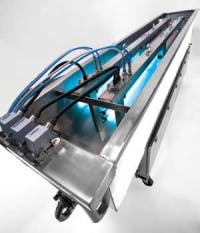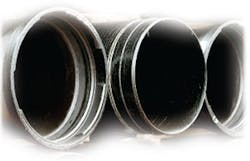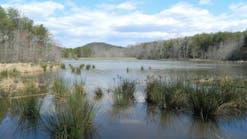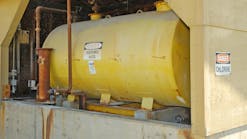By Carlos David Mogollón, Managing Editor
Gary White, co-founder of Water.org and founder of its predecessor WaterPartners InternationalKANSAS CITY, MO, Oct. 1, 2009 -- After two decades leading WaterPartners International, his startup non-governmental organization specializing in clean water solutions in the developing world, Gary White partnered with actor Matt Damon's H2O Africa Foundation to create Water.org this past summer.
The following interview with White corresponds with an Executive Watch column ("Star Power Adds to NGO Effort in Third World") that appeared in the October/November 2009 issue of Water & Wastewater International.
For more, read on:
WWi: So, Water.org is basically a guarantor in a sense of NGOs involved in the water sector basically, not so much an organization directly involved in projects as much as identifying organizations that are successful at implementing them efficiently and helping coordinate funding for their efforts?
White: Correct, our staff members are not on-the-ground actually digging the wells. Our main value is the intellectual capital that we bring, including the rigorous evaluation and certification processes that allows local NGOs to join our global partner network. These local partner organizations are based in the countries that we serve, and understand, and are a part of, the local culture. This helps to ensure that solutions are tailored to the community, appropriate, and sustainable in the long run. We raise the funds for our projects that are implemented by our partners.
White (2nd from left) with former U.S. president Bill Clinton and actor Matt Damon at the Clinton Global Initiative's 2009 annual meeting where they announced Haiti as Water.org's next focus country of interestWWi: Your organization, WaterPartners International, just merged with one co-founded by Matt Damon, H2O Africa Foundation, to form Water.org. Tell us how that came about, what synergies the two organizations have and what you hope to accomplish by the move?
White: The merger leverages the expertise of each organization and increases the overall social return on donations. The result: far more people with access to safe drinking water and sanitation.
Matt Damon and the other co-founders of H2O Africa did a tremendous job of advancing its mission by creating widespread public awareness of the water crisis in Africa and gathering support for clean water programs. The natural next question was how best to deploy the funds raised. That's where WaterPartners and its nearly two decades of on-the-ground water project success entered the picture.
Our news release does a good job of capturing this [see: "Water.org Working Toward Global Access to Safe Water], as does our online Q&A -- both released with the July announcement.
WWi: So, Water.org is basically a guarantor in a sense of NGOs involved in the water sector basically, not so much an organization directly involved in projects as much as identifying organizations that are successful at implementing them efficiently and helping coordinate funding for their efforts?
White: Correct, our staff members are not on the ground actually digging the wells. Our main value is the intellectual capital that we bring, including the rigorous evaluation and certification processes that allows local NGOs to join our global partner network. These local partner organizations are based in the countries that we serve, and understand, and are a part of, the local culture. This helps to ensure that solutions are tailored to the community, appropriate, and sustainable in the long run. We raise the funds for our projects that are implemented by our partners.
WWi: I noticed that "microfinance" -- i.e., your WaterCredit Initiative -- is a big part of the equation of what you do. The value of microfinance as a function of allowing the have-nots around the world, and not just the poor in developing nations, help themselves has gotten a lot of attention in recent years, with awards that include a Nobel Peace Prize in 2006. Can you talk about that and benefits both with respect to water and beyond?
White: The establishment of a viable, commercial market for water and sanitation loans provides a means for empowering a large segment of the people living without access to safe water or sanitation who could afford to finance their own solutions over time. It also helps to build up local economies. Empowering the people in need to participate in their own solutions reduces dependence on international aid, which has shown mixed results at best in meeting the long-term water and sanitation needs of the world's poor.
WWi: How long was WaterPartners in existence and how did it get started? I understand its origins go back to your college years, both as an undergraduate and post-grad. What prompted the interest in water, on your part? Can you tell us about that and the organization's evolution?
White: As an undergraduate student at the University of Missouri-Rolla (now Missouri S&T), I founded an organization to enable engineering students to volunteer their time on development projects around the world. It was during a trip to Guatemala with this organization that I had a powerful experience of how most people in the world live. The sources of drinking water shocked me the most. These sources represented sickness and death, especially for children whose immune systems cannot cope with waterborne diseases. Since this experience, I have committed myself personally and professionally to finding the best avenue for addressing global water needs. I co-founded WaterPartners in 1990 to address the global water crisis, in a new, more sustainable way. Our growth trajectory right now is pretty amazing. At the end of FY04, our revenue was $827,000 and the cumulative number of people we had served was 25,000. At the end of FY09, our revenue was $6 million and the cumulative number of people served was 400,000.
WWi: When did WaterPartners formally coalesce into what it was just prior to this merger to form Water.org -- and what accomplishments would you highlight in its 20-year history?
Gary White visiting drinking water project in IndiaWhite: Innovation has always been part of the DNA of WaterPartners – and now Water.org. When I co-founded WaterPartners nearly 20 ago, I pioneered the approach of simultaneously addressing water, sanitation and hygiene education in our projects. This is now standard best practice. In 2004, we launched the pilots for WaterCredit with two $1 million grants from the Open Square Foundation and the Michael & Susan Dell Foundation. In 2008, PepsiCo Foundation gave us a $4.1 million grant to expand WaterCredit in India. WaterCredit has seen tremendous success, reaching more than 130,000 people with clean water and sanitation access. In March 2009, WaterPartners received the Skoll Award for Social Entrepreneurship for this initiative.
WWi: I would imagine that with Matt Damon on board, that's brought a lot more attention to your mission -- not just from the media in general but celebrities and the public as well. How did you meet him and what benefits does having "Hollywood" backing bring to your organization's efforts? Are there other actors that have gotten involved in water issues due to this relationship?
White: I first met Matt Damon a little more than a year ago, in New York City, where I was introduced to him by a mutual friend, Marc Joubert. Having Matt on board certainly helps to open new doors, and to open even wider doors that were already ajar. We're increasing grassroots awareness of our organization and the global water crisis, and reaching new audiences that may not otherwise have heard about us.
Just recently, at the 2009 Annual Meeting of the Clinton Global Initiative, Matt and I joined Bill Clinton on stage for the opening plenary session, to provide a progress report on the current $9 million in CGI commitments we are implementing and to announce our launch into Haiti. The October issue of Esquire magazine featured Matt on the cover, and the story followed the July trip Matt and I took to India to visit project sites and assess progress of our WaterCredit program there. The October 11 issue of Parade magazine featured Matt on the cover and included a story that he authored. He used this story that reached more than 70 million readers to highlight the work of Water.org.
WWi: You had mentioned that Matt wasn't just a silent partner but is intensely interested in learning about the plight of the water and sanitation deprived and finding solutions to these problems. What role do you see him playing within Water.org?
White: Matt is incredibly knowledgeable about the water and sanitation crisis, and since July, he has already visited Water.org project sites with me in Ethiopia and India. I see his role as continuing to open doors for Water.org, increasing public awareness of the global water crisis, and helping to catalyze public action to help address it.
WWi: It was mentioned to me that Water.org was planning on announcing at the Clinton Global Initiative conference that it would be expanding into Haiti. Tell me a bit about that?
White: At the opening plenary of the Clinton Global Initiative Annual Meeting, we announced Water.org's $2 million commitment to provide 50,000 people in Haiti with safe water and sanitation over the next three years.* As part of the commitment, we've launched a social media campaign (via Facebook and Twitter) so that anyone can participate in meeting the water challenge in Haiti.
For more information, a news release, commitment to action, as well as the video of Matt making the Haiti announcement at CGI is available at our website: click here. This announcement was picked up by a variety of news outlets around the world, even People magazine.
* SEE: Matt Damon @ Clinton Global Initiative [WaterWorld/Community Portal]
WWi: What's the size of Water.org's portfolio today vs. where it was five years ago for its parent organizations -- or even a year ago?
White: Water.org has grown significantly in the past five years. At the end of our fiscal year 2004, our revenue was $870,000 and the cumulative number of people we had served was 25,000. We ended our fiscal year 2009 with revenue of $6 million and 400,000 people served cumulatively over the lifetime of our organization.
WWi: Where does the majority of its funding come from, or how is that split up among key sources?
White: Foundations comprise 80% of our funding. Individuals comprise 15% and sources such as corporate and governmental grants comprise the remaining 5%.
WWi: Tell me a little bit about how far and wide Water.org currently operates, with possibly a few examples of what's being done in different regions of the world?
White: Water.org currently operates in four main geographic areas: Asia, Central America, East Africa, and West Africa.
In Asia, Water.org's work focuses on Bangladesh and India, where it implements both traditional grant programs as well as WaterCredit programs. Our Bangladesh programs target the slums of the capital city, Dhaka, and the rural Rajshahi and Manikganj Districts.
Water.org's projects in India serve communities in five states -- Andhra Pradesh, Karnataka, Madhya Pradesh, Orissa, and Tamil Nadu. Rural projects are located in the District of Tiruchirappali in the southeastern state of Tamil Nadu and in Ganjam in the state of Orissa. Urban projects are located in the slums of Tiruchirappali, Bangalore, Hyderabad, Delhi, and Indore.
Gary White with children in Africa where Water.org assisted on a project to bring them clean waterIn East Africa, Water.org is active in Ethiopia and Kenya. Ethiopian projects are located in the regions of Tigray and Oromia, and are grant-only. Kenyan grant and WaterCredit projects take place in the western region of the country.
In West Africa, Water.org is active in Ghana and will soon be expanding to additional countries.
Central America is home to Water.org's first project, which took place in Honduras in 1990. Today, Water.org has helped more than 40 Honduran communities build their own safe drinking water systems. Water.org has also implemented projects in El Salvador, Guatemala and the Philippines. All of these have been grant projects.
WWi: How much of what Water.org does is the WaterCredit program, and are there specific projects that highlight both the challenges to be overcome and potential successes that can be achieved?
White: While WaterCredit initiatives first started in 2004, the number of people served by WaterCredit initiatives (130,000 people) comprises approximately 34% of all people served by the organization since its inception in 1990.
A report at our website, "Credit for Water and Sanitation Improvements: A Case Study of Women's Self-Help Groups in Tamil Nadu, India," provides an example of a project that highlights both the challenges and success of WaterCredit. The "Discussion" section at the end of the document offers a concise overview of findings.
WWi: WWi recently had an article co-authored by new Water For People CEO Ned Breslin on issues related to "Gender & Water." And I noticed in the executive summary of the WaterCredit 2.0 initiative of your organization that 90% of the people involved in that loan program are women. I bring it up because I recall one of my college classes, "Developmental Problems in the Third World" -- we're talking mid-'80s -- focused on the fact that most of the world's problems could be improved by improving the lives of women in some fashion. Can you touch on that issue and different aspects of how the WaterCredit program operates as such?
White: Women are greatly invested in having access to clean water. It is women who bear the primary responsibility for keeping their households supplied with water; caring for the sick (water-related disease being a primary source of illness); maintaining a hygienic home; and raising healthy children. In many parts of the world, women spend hours each day collecting water. Because of this, women are highly motivated to take charge to change their situation -- if they have the opportunity. WaterCredit provides this opportunity. Often, WaterCredit loans are made to women's self help groups. These groups of strong, motivated women serve as the credit guarantees for each other. We're seeing repayment rates of 98% and higher for WaterCredit.
Once a woman has ready access to water, her life improves in many ways. First, she has more available time. This means more time to work at an income-generating job and to care for her family. Plus, by taking out a WaterCredit loan, women are able to establish a credit history. This allows them to take out a loan from a commercial bank for another purpose. For example, a woman may purchase a sewing machine to start a home tailoring business. Taking out the WaterCredit loan often improves a woman's status within her home and community. These are just a few of the ripple effects of WaterCredit for women.
WWi: Since it's been noted recently in WWi -- 2008 being the International Year of Sanitation -- that the world is lagging moreso on achieving sanitation targets* under the UN Millennium Development Goals, how much of what Water.org does is focused on drinking water supply vs. sanitation issues? Is there any difference to how you approach these two issues?
White: Since day one -- and that's 20 years ago now -- sanitation and hygiene education have been a critical component of all of our programs. Adoption of good hygiene practices and access to sanitation facilities are critical to achieving sustainable improvements in community health. Water.org's local partners hold intensive training and motivation seminars throughout the project on the link between good hygiene and good health.
Interestingly, in India we're seeing greater demand for WaterCredit loans for toilets than for water. This is clearly an issue of great need. Women and girls suffer especially from lack of sanitation. Lack of separate sanitation facilities for boys and girls is a major cause of girls dropping out of school. And women who are forced to relieve themselves under cover of darkness are more vulnerable to physical attack and rape, not to mention health problems associated with waiting all day to relive oneself.
WWi: I would imagine that working in different areas of the world means that you have to be culturally sensitive to how things are done in different places. Can you give any examples of this?
White: You're absolutely right. That's an important part of why we work through all local partner organizations that are based in the countries we serve. Our partners understand, and are a part of, the local community. We take our cues from them and collaborate with them on designing programs that take local cultural issues into account. One example of this is our efforts to empower women in water programs because they are critical to ensure water systems are sustained. In India it is fairly easy to empower women in this way and they manage all aspects of programs. In Honduras we have had to adapt somewhat by allowing local communities to have more male representation on local water committees. However, our criteria call for at least half these positions be women.
WWi: What are some of your goals over the next year and the next five years?
White: Some of the goals include: 1) continue to develop and scale our WaterCredit initiative, 2) expand geographically (we're currently looking at expansion into Haiti), 3) intensify our advocacy efforts in the US, and 4) increase awareness of the water crisis and Water.org among grassroots donors.
WWi: Do you see any particular challenges that may affect that, whether we're talking about the global credit crisis and recovery from the recent recession, economic commitments of G20 nations, the interplay of development vs. terrorism, global population growth, and climate change?
White: All of these issues will impact the goal of safe water for all -- the challenges are many but are not insurmountable. However, the biggest challenge by far is indifference on the part of those who can help. The financial resources needed to achieve global access pale in comparison to other global expenditures. We don't need to find a miracle cure for this problem. We know how to do it today. As a planet we should be embarrassed and outraged that a child still dies every 15 seconds because of something so many of us take for granted. We just need to commit to solve this problem.
WWi: I had one more question I wanted to add into the mix because it would seem to weigh heavily on long term water security goals worldwide... I was reading recently that the world population, which broke 6 billion in only 1999, is already nearing 7 billion and expected to reach 9 billion by 2030. How do you factor that into water and sanitation issues in areas where Water.org works?
White: There are certainly enough fresh water resources on the planet to sustain 9 billion people. The question is the availability of those resources relative to population growth. For the regions where we work in Africa and Latin America the water resources relative to population growth will be manageable using our current models. However, we will need to carefully review how we work in Asia, particularly in India and Bangladesh where climate change and population growth will be very challenging. I foresee us focusing more on advocacy, policy and water conservation in those areas to make sure water resources can be allocated fairly and efficiently.
WWi: In closing, what lasting message do you hope people take away from this interview?
White: No matter what country we are in, or whether our project is grant- or WaterCredit-based, our goal is the same -- empowering people to achieve safe, sustainable, and affordable access to water supplies and sanitation. People on both ends, the poor and the powerful, must believe that the poor can meet their own needs. I know I do; I've seen it over and over again firsthand. This is the principle upon which I built Water.org and the WaterCredit program. With the right tools, together we can achieve the global access to clean water.
--
Related Articles:
-- "Water is Medicine: Why act now on the water and sanitation crisis" [4 Aug 2009]
For more information, contact:
Water.org
2405 Grand Blvd.
Suite 860, Box 12
Kansas City, MO 64108-2536 USA
Tel: +1 913-312-8600
Email: [email protected]
Web: www.water.org
###
Sponsored Recommendations
Sponsored Recommendations
ArmorBlock 5000: Boost Automation Efficiency
April 25, 2024
State of Smart Manufacturing Report Series
April 25, 2024





